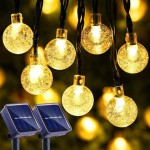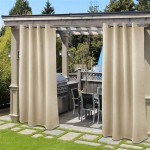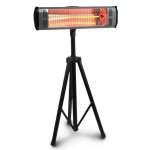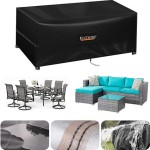Outdoor Electric Heaters with Fan: Efficient Warmth for Open-Air Spaces
Outdoor electric heaters with fans offer a practical solution for extending the usability of patios, decks, and other outdoor spaces during cooler months. These heaters combine the efficiency of electric heating with the forced-air circulation of a fan, resulting in a more effective and even distribution of warmth compared to radiant heaters alone. Understanding the mechanisms, benefits, and considerations associated with these appliances is crucial for making informed purchasing decisions and optimizing their performance.
An outdoor electric heater with a fan typically comprises several key components: a heating element, a fan, a housing unit, and a control panel. The heating element, usually constructed from a resistive material like nichrome, generates heat when an electric current passes through it. The fan, driven by an electric motor, draws air across the heated element and propels the warm air outwards. The housing, made from durable materials like stainless steel or powder-coated aluminum, protects the internal components from the elements. The control panel allows users to adjust settings such as heat output and fan speed.
The operational principle is relatively simple. Electricity powers the heating element, which converts electrical energy into thermal energy. Simultaneously, the fan draws in ambient air and forces it over the hot heating element. This process heats the air, which is then expelled into the surrounding area, creating a localized zone of warmth. The fan significantly enhances the heater's efficiency by rapidly dispersing the heat and preventing it from simply rising and dissipating into the atmosphere.
Enhanced Heat Distribution and Efficiency
The primary advantage of an outdoor electric heater with a fan is its superior heat distribution. Radiant heaters, which emit infrared radiation, primarily heat objects and individuals directly in their path. This can lead to uneven heating, with some areas feeling warmer than others. Furthermore, radiant heat is susceptible to being carried away by wind. Heaters equipped with a fan actively circulate the warmed air, ensuring a more uniform temperature across a larger area. This makes them particularly effective in outdoor environments where wind and drafts can quickly diminish the effectiveness of traditional radiant heaters.
The forced-air circulation also contributes to greater energy efficiency. By distributing the heat more effectively, less energy is required to maintain a comfortable temperature. The fan ensures that the heat is directed where it is needed most, minimizing wastage. Users can typically adjust the fan speed and heat output to fine-tune the heater's performance according to the ambient temperature and the size of the area being heated. This level of control allows for optimized energy consumption and reduced operating costs.
Additionally, some models incorporate features like thermostats and timers that further enhance energy efficiency. A thermostat automatically regulates the heat output to maintain a pre-set temperature, preventing overheating and unnecessary energy consumption. A timer allows users to program the heater to operate only during specific hours, further reducing energy costs.
Safety Considerations and Features
Safety is paramount when operating any electrical appliance, particularly in outdoor environments. Outdoor electric heaters with fans are typically designed with several safety features to mitigate potential hazards. Many models include tip-over switches that automatically shut off the heater if it is accidentally knocked over. This feature prevents fires and electrical shocks.
Overheat protection is another common safety feature. If the heater's internal temperature exceeds a safe level, the overheat protection mechanism will automatically shut off the appliance to prevent damage and potential fires. This is particularly important in heaters with fans, as a malfunctioning fan can cause the heating element to overheat.
Furthermore, outdoor electric heaters are often designed with weather-resistant housings to protect the internal components from rain, snow, and other environmental factors. The electrical components are typically sealed to prevent water ingress, which can cause short circuits and electrical shocks. However, it is crucial to check the Ingress Protection (IP) rating of the heater to ensure it is suitable for the intended outdoor environment. A higher IP rating indicates greater protection against water and dust.
It is also important to follow basic safety precautions when using an outdoor electric heater. Ensure that the heater is placed on a stable, level surface, away from flammable materials such as curtains or dry leaves. Never leave the heater unattended while it is in operation, and always unplug it when it is not in use. Regularly inspect the power cord for any signs of damage, and replace it if necessary. Using a dedicated circuit for the heater can also help prevent overloading the electrical system.
Selecting the Right Model and Features
Choosing the appropriate outdoor electric heater with a fan requires careful consideration of several factors, including the size of the area to be heated, the ambient temperature, the heater's power output, and the desired features. The heater's power output, measured in watts or kilowatts, determines its heating capacity. A higher wattage heater will generate more heat and is suitable for larger areas or colder climates.
The size of the area to be heated is a crucial factor in determining the required power output. As a general guideline, calculate the square footage of the area and consult the heater's specifications to determine if it is appropriately sized. Consider that open and exposed areas may require more heating power than enclosed spaces.
Features such as adjustable heat settings, variable fan speeds, thermostats, and timers can significantly enhance the user experience and energy efficiency. Adjustable heat settings allow users to fine-tune the heat output according to their preferences and the ambient temperature. Variable fan speeds provide greater control over the airflow and heat distribution. Thermostats and timers, as previously mentioned, help to conserve energy and maintain a comfortable temperature.
The heater's design and portability are also important considerations. Some heaters are designed to be mounted on walls or ceilings, while others are free-standing and can be easily moved. Consider the available space and the desired placement of the heater when making a decision. Portable heaters offer greater flexibility, allowing users to move them to different locations as needed. However, wall-mounted or ceiling-mounted heaters may provide a more permanent and space-saving solution.
Finally, consider the heater's noise level. Some heaters with fans can be quite noisy, which may be undesirable in certain settings. Look for models that are advertised as being quiet or that have noise reduction features. Reading product reviews and comparing specifications can help determine the noise level of different models.
Maintenance of an outdoor electric heater with a fan is relatively straightforward. Regularly clean the heater's housing and fan blades to remove dust and debris. This will help to ensure optimal performance and prevent overheating. Check the heating element for any signs of damage, and replace it if necessary. Store the heater in a dry, protected location when it is not in use to prevent corrosion and extend its lifespan.
By understanding the features, benefits, and considerations associated with outdoor electric heaters with fans, individuals can make informed decisions and enjoy the comfort and warmth of their outdoor spaces throughout the year. Proper selection, installation, and maintenance will ensure safe, efficient, and reliable operation for years to come.

Paragon Outdoor 120 Volt Black Aluminum Electric Patio Heater Oh E815b At Lowes Com

Electric Patio Heater Sloht24

Infratech W Series Single Element 1500 Watt 120v Outdoor Infrared Electric Heater 33 In Radiant W1512 Fireplaces

Energ Infrared Electric Outdoor Heater Bistro Table

Bromic Tungsten Smart Heat Electric Patio Heater Royal Fire Pits

Big Ass Fans Obsidian Electric Heater 42 In 240v

Bromic Eclipse Smart Heat Portable Radiant Infrared Outdoor Electric Heater

Big Ass Fans Bafcf15120b 27 Ceiling Mount Indoor Outdoor Electric Infrared Heater 1500 Watt 120v

Climatesafe By Climateright Electric Heater And Bonus Internal Fan For Outdoor Dog Pet Animal Enclosures Wall Mounted

The 5 Best Outdoor Patio Heaters Of 2025 Reviews By Wirecutter








